Facilities General Information
The Buffalo County Facilities OMP department strives to provide extraordinary, professional and reliable building management services for all of the county facilities. Our Facilities Staff are trained professionals who are committed to providing a clean, safe, secure and functional building environment for both the county staff and the general public. Buffalo County Facilities OMP includes Operations (Custodial and Maintenance), Management (Facility Rental Use and Administrative Services), and Planning (Short term and long term improvements).
The 14 members of the Facilities OMP staff are responsible for maintaining all County Government buildings, including the Courthouse, Judicial Center, County Jail, Highway Department
buildings, Extension Building, 4 office buildings, and a recreation area with a lake and campground. There are over 30 buildings in total. In addition to these facilities, Facilities OMP maintains 11 parking lots, all walkways, steps and lawns adjacent to these areas, including landscaping, and provides snow and ice removal during the winter. The staff meet regularly to review work practices and safety regulations. They take part in additional training to keep up to date on the latest practices and procedures
relative to the cleaning, maintenance, security, and protection of County facilities, employees, and the general public.
"Facilities Operations" includes:
Custodial Services
Our Custodial Staff are trained cleaning professionals who are committed to providing a safe, clean and presentable building environment. We provide custodial services for 10 of our County buildings, their entrances, surrounding grounds, and parking areas. These buildings include:
--Buffalo County Courthouse
--Buffalo County Judicial Center
--Buffalo County Jail/EOC Center
--DHHS
--Adult Probation
--Juvenile Probation
--Extension Building
--215 Office Building
--Buffalo County Highway Department
--Buffalo County Weed District
Maintenance Services
Our Maintenance Staff are trained maintenance professionals who are committed to providing a safe, secure and functional building environment. Their work includes:
--Planned/Preventative Maintenance - includes inspections, servicing, general upkeep to buildings, equipment and grounds.
--Reactive/Unplanned Maintenance - repairing breakdowns of our facilities and grounds
--Overseeing underground fuel storage tanks/piping/lines and ensuring compliance with government regulations
--Monitoring/Maintaining Building Management Systems including HVAC controls, fire alarm systems, etc.
--Emergency Maintenance - assessing/repairing/coordinating repairs to critical system breakdowns
--Snow and Ice Removal
"Facilities Management" includes:
Facility Rental Use
The Facilities OMP department is responsible for facilitating the rental use of county facilities. At this time the principle location of this usage is the Buffalo County Extension Building. The responsibility includes:
--Schedule the usage of the Extension Building meeting rooms & kitchen, and maintain the master schedule
--Process all requests for usage of the meeting rooms & kitchen, and insure compliance with Board policies and regulations
--Execute rental contracts for outside group usage and collect rental fees associated with each agreement
--Verify appropriate requirements are met by groups using the facility
--Provide Facility Assistant when required, for groups with alcohol
--Provide proper access to scheduled groups
--Prep building for usage and follow up to ensure that it has been returned in proper condition
Administrative Services
Operations
--Ensure compliance with employment rules/regulations, county policies, and all applicable state and federal laws/regulations
--Oversee the daily operations of the Facilities OMP workforce and the work assignments
--Monitor, inspect and review the daily operations of the County facilities and grounds
--Manage installations, repairs, equipment testing and contracted maintenance by outside sources
--Oversee the development and implementation of operational policies and procedures
--Utilize and administer facility/building management software systems to manage the county facilities
--Coordinate professional development of Facilities OMP staff through training and workshops
--Have a representative on the County safety committee and any other committee as requested
Procurement
--Review and manage contracts related to county facilities
--Manage Facilities OMP equipment, materials and supplies and order inventory/supplies when needed
--Develop and maintain strong vendor and contractor partnerships to ensure the best quality, cost, and customer service for the County.
--Procure building equipment and supplies as needed for facilities
Claims/Accounts Payable
--Review and keep record of monthly bills and claims against Facilities OMP, including all utility bills for all County buildings
Budget
--Develop and manage Facilities OMP budgets, including preparing and maintaining a yearly budget
--Create cost estimates for anticipated individual projects.
--Manage budgeted costs on projects as they occur.
Management Software System - Facility Dude
--Facility management software utilized by the County
--Work tickets are generated by county employees needing custodial or maintenance assistance. All work requests need to be submitted on a work request utilizing Dude Solutions software (FacilityDude).
--Work tickets are assigned to Facilities staff and/or contractors for work orders
--Additional "preventative maintenance" work tickets are also generated with FacilityDude for scheduled servicing/inspecting/upkeep.
--Once the work has been completed, the work tickets are closed out and a follow up email is sent to the requestor to let them know that the work has been completed
--Data is collected from the information inputted into FacilityDude and utilized for managing current costs and projecting future expenses/budgeting
"Facilities Planning" includes:
Planning, Design & Development
--Develop and implement one, two and six year department plans
--Small Scale - Develop and implement small scale adjustments to
existing spaces to keep space up to date and adequate for current
usage needs.
--Large Scale - Coordinate design, engineering and construction of all Capital improvements including new buildings, new additions to existing buildings, and remodels of existing buildings.
--Ensure compliance with all applicable local, state and federals laws and regulations related to buildings and grounds
Juvenile Justice System Guide
“The only real mistake is the one from which we learn nothing.”
--John Powell
REASONS FOR BEING IN COURT
Delinquent: charged with breaking a law of a State or City Ordinance.
Status Offender: Charged with being beyond control of his/her parent(s) or habitually truant. Examples include not going to school, not keeping a curfew, running away from home, not obeying parent rules, and using drugs, alcohol or tobacco under age.
WHAT THE COURT MAY DO
Delinquent: May be placed on probation under the supervision of a Probation Officer at home or in a group home or other restricted program. The Court may alternatively place a delinquent in the custody of the State Office of Juvenile Services (OJS) / Health and Human Services (HHS) where he/she may be supervised at home, in another placement in the community (such as foster care, group home, or residential treatment), or at the Youth Rehabilitation Treatment Center (YRTC) in Geneva or Kearney.
Commitment to Office of Juvenile Services / Health and Human Services (HHS): HHS provides Court-ordered services to youth including those of the Office of Juvenile Services, the Youth Rehabilitation Treatment Centers, and Out of Home Placement.
Status Offender: Special supervision may be required. Offender may be placed at home on Probation or made a State Ward through the Department of Health and Human Services for out-of-home placement or services in the home.
YOUR RIGHTS
You have a right to:
- Know what has been filed against you;
- An attorney (a Public Defender may be provided at no cost);
- Face and cross-examine witnesses;
- Present evidence in your own defense;
- Testify if you wish; however, you do not have to testify;
- Be advised by the Judge as to what the Court can do with you; and
- Appeal the Court’s decision to the Nebraska Court of Appeals or Nebraska Supreme Court.
ADVICE FOR COURTROOM BEHAVIOR
DO…
- Dress neatly and cleanly, as you would for an important meeting.
- Be 15 minutes early, so you are ready to attend the hearing on time.
- Speak loudly and clearly.
- Be honest and make eye contact when talking.
- Respond to Judge’s questions by saying, “Yes, Your Honor,” or “No, Your Honor.”
DO NOT…
- Curse, swear or lie;
- Get angry or roll your eyes;
- Walk out of the courtroom (you could be held in contempt;
- Speak or act rudely;
- Take a cell phone into the courtroom;
- Slouch or chew gum; or
- Wear sagging pants, offensive T-shirts or gang-related items.
DETENTION
Confinement in a locked facility for a period of time until your case is tried or a more suitable placement is found.
STAFF-INTENSIVE PLACEMENT
Unlocked staff-intensive placement for a period of time until your case is tried or a more suitable placement is found.
YOU MAY BE PLACED AT A DETENTION OR STAFF-SECURITY FACILITY IF YOU…
- ...fail to follow court orders (any law violation, including Court orders to obey your parents’ rules and curfew, and/or attend school).
- ...are a runaway youth (a history of running from home or if you run from your Court-ordered placement, such as foster or group home).
- …are a danger to yourself or others (violent, aggressive, gang-related behavior or use of alcohol or drugs).
- ...are being discharged unsatisfactorily from a placement facility. If you are not following rules of your Court-ordered placement and are discharged, you may be detained.
- ...an OJS evaluation is ordered to be done residentially.

An evaluation can be ordered by the judge to be completed while you are detained.
WHEN A YOUTH IN CHARGED WITH A CRIME:
| Step |
Description |
| 1. Arrest |
Upon arrest by Law Enforcement, the Officer may: 1) Street-
release, 2) Cite and release to a parent, or 3) Arrest and get authorization to detain.
|
| 2. Detention Decision |
If recommended by Law Enforcement, a Probation Officer assesses for detention or release to parent. If detained, the Deputy County Attorney reviews all information files the appropriate Petition and requests a hearing, which should be held in a timely manner. The Court reviews all facts and determines if further detention is needed. A Petition generally must be filed within 48 hours of detention, excluding weekends and holidays. If the youth is not detained, a report is forwarded to the County Attorney for a filing decision.
|
| 3. Filing |
A petition is filed in the court, or declined. The matter might be diverted without filing a Petition. The County Attorney may decide to charge the youth in Adult Court. If charged with a felony or misdemeanor, the youth could be detained.
|
| 4. Arraignment |
Prior to the hearing, the youth meets with his/her attorney to discuss charges and how to proceed. Through the attorney, a plea of admission, denial, or no contest is entered. If the youth denies the charge(s), the Court will schedule an Adjudication Hearing. If youth admits to the charge(s), the Court will schedule a Disposition Hearing and may order evaluations.
|
| 5. Adjudication |
This is the trial of the Petition, where the State must prove up on the charge(s). If Court finds the Petition to be true, Court acquires jurisdiction of the youth and the matter is then set for disposition. If the Petition is not found to be true, the case is dismissed.
|
| 6. Predisposition Investigation |
The Court may order a predisposition investigation (PDI) by a Probation Officer prior to the disposition hearing, which involves Collecting information from the youth, his/her family, the schools, previous mental health providers, and others. This is so the Judge can make an informed decision about how best to hold the offender accountable and address his or her specific needs. More evaluations may be required (such as chemical dependency or mental health). In abuse-neglect cases, the PDI and other evaluations are done by the Office of Juvenile Services (OJS).
|
| 7. Disposition Hearing |
Based on the PDI and other case information, the Court orders a plan to ensure accountability and rehabilitation. The plan could include out-of-home placement, further evaluation, treatment, probation, intensive supervision, or other services.
|
FREQUENTLY ASKED QUESTIONS
What is Juvenile Court?
Nebraska laws have separate guidelines for juveniles (as opposed to adults, age 18 and over) who have violated the law or have other behaviors in need of intervention. Juvenile Court involvement is not considered to be a criminal record, but is intended to provide the juvenile an opportunity for rehabilitation.
What is a petition?
A petition is a legal paper, filed in the Court, outlining why you are being brought to court.
How will I know when to go to court?
You will receive a summons or letter giving the date, time, and location. The number of times you attend depends on individual circumstances. Inform the Court and Probation Officer of address or telephone changes.
What if I miss a hearing?
The judge could order you to be picked up by law enforcement, detained, and brought before the Court to explain why you ignored the Court’s notice.
What if I do not follow the Court’s rules?
A motion to review or revoke your placement or probation may be filed by the County Attorney, asking the Court to place more severe requirements on your probation or place you in an institution or state juvenile correctional facility.
Can my record be sealed (kept confidential)?
You may ask the Court to seal your records. This sets aside the record and it cannot be opened without Court approval and good cause. However, even if sealed, certain persons or agencies may still be able to access your records.
What if I waive the right to an attorney?
If you do so, you would be representing yourself. If you do not have an understanding or knowledge of legal options and process (such as motions to make, how to call and examine witnesses, and how to request services from the Court), you may be adversely affected. Remember, you can request an attorney to represent you at any point in the process.
| Office |
Phone Number |
| Attention Center |
(308) 236-1922 |
| County Attorney’s Office |
236-1222 |
| County Court |
236-1228 |
| City of Kearney Attorney’s Office |
237-3155 |
| Crisis Assistance Center |
(800) 325-1111 |
| Detention Center |
(308) 233-5281 |
| District Court |
236-1246 |
Health & Human Services (HHS)
• Geneva/Kearney
• Office of Juvenile Services (OJS)
• Out-of-home Placements
• Youth Rehabilitation and Treatment Centers
|
865-5592 |
| Juvenile Diversion |
236-1922 |
| Truancy/Juvenile Diversion |
236-1920 |
| State Probation |
236-1251 |
| Buffalo County Sheriff |
236-8555 |
Kearney Police Department
• non-emergency
• EMERGENCY
|
237-2104
911 |
| Family Resource Council |
237-4472 |
| Nebraska Workforce Development |
865-5404 |
Region III
• Early Intensive Care Coordination
• Professional Partner Program
|
237-5113
Ext. 238
Ext. 238 |
| Buffalo County Community Health Partners |
865-2284 |
Each individual is entitled to be, and is capable of being, responsible for his or her lawful participation in society.
Revised from the Crime Commission brochure “A Guide to Juvenile Court for Parents & Children.”
A printer-friendly version of this page is available.
Drug Court
Purpose:
The Central Nebraska Drug Court seeks to improve public safety, and reduce substance abuse and crime by providing offenders with appropriate treatment, intensive supervision and comprehensive judicial monitoring.
The Drug Court serves Adams, Buffalo, Hall, and Phelps Counties in Nebraska. It is administered by the District Courts of the Ninth and Tenth Judicial Districts.
What is the Central Nebraska Drug Court?
The Drug Court is a voluntary program created by the District Court that allows eligible defendants to earn a dismissal of charges in exchange for completing substance abuse treatment and other conditions.
Individuals eligible for the Drug Court will earn a dismissal of pending felony charges upon completion of the Drug Court program, a minimum of eighteen months in length.
The County Attorney must approve all requests for the Drug Court.
What are the Drug Court Requirements?
Each person’s requirements and conditions may be different depending on individual circumstances. However, the general requirements for everyone include:
- Complete a comprehensive assessment with the Drug Court staff
- Complete the substance abuse treatment recommended by the Drug Court staff
- Attend regular appearances before the Drug Court Judge
- Submit to regular drug testing
- Pay a weekly program fee to the Drug Court
- Pay part of the costs of treatment, based on ability to pay
- Reside in a participating county while in the program
- Maintain employment, attend school, or complete other conditions as directed by the Court or staff
- Meet with the Drug Court staff
- Pay any court costs due
- Obey all laws
Who is eligible for the Drug Court?
Certain offenses will qualify for Drug Court, some will not. Generally, there must be no more than one prior felony conviction. The County Attorney must approve all applicants.
Also, the participant must acknowledge having a substance abuse problem and agree to complete drug and/or alcohol treatment. Applications for Drug Court must be made within thirty days after arraignment in District Court. The Judge must approve all petitions for admission to the Drug Court.
Who is NOT eligible for the Drug Court?
- If charged with an ineligible offense, such as murder, manslaughter, robbery, felony assault, sexual assault, or assault with a deadly weapon
- Prior felony conviction for a crime of violence
- Prior or current offense involved the use or possession of a firearm or a dangerous weapon
- Prior or current offense resulted in death or serious bodily injury
- Current offense involved the use of force against a person
- Two or more felony convictions
- Multiple prior misdemeanors for crimes against a person, such as assault, domestic violence, resisting arrest, assaulting a law enforcement officer, or flight to avoid arrest
How to apply for the Drug Court
If you meet the eligibility criteria and want to apply for the Drug Court, consult with your attorney immediately.
General questions can be directed to:
Susan Huber
Problem Solving Court Coordinator
610 Central Avenue
Kearney, NE 68847
Telephone: (308) 236-1240
Your Day in Court
Several different types of cases involving paternity and/or child support are handled by the Buffalo County Attorney’s Child Support Services office. Often these cases will be scheduled for trial or other court hearing. Your attendance may be required at one of the hearings. This section is designed to provide parties and other court witnesses with basic information about appearing in court. Additional information may be provided to you by your attorney, if you have one, or a member of our office who is assigned to your case.
Notice of court hearings
If you are required or requested to appear for trial or other court hearing you will typically receive notice of the hearing one or two weeks ahead of time. Occasionally you will be notified closer to the hearing date, if, for instance, the court has only given our office a short notice of the trial date. Paternity and child support cases are typically heard on only two days each month (typically Wednesdays and Thursdays). Scheduling of your hearing is limited to the available dates given to us by our court.
Types of hearings
Over 80 percent of child support related court hearings fall into one of three categories:
- Paternity establishment;
- Orders to Show Cause, also known as “contempt” hearings; or
- Child support modifications
The court also hears requests to appoint counsel for indigent parties, as well as requests to suspend or reinstate child support. Other issues may be addressed by the court as needed.
Length of Hearings
Up to twenty court hearings are typically scheduled each day before the child support referee, who is the hearing officer appointed by the district judges to receive evidence and make final recommendations to the district judge. The length of hearings ranges from ten minutes to the better part of a day, in more complicated cases. Most hearings take less than one hour to complete. Occasionally hearings will be recessed or “continued” until another date, when the court’s schedule or other factors dictate. Court hearings are scheduled between 9 am and 3 pm.
It is a good idea to bring a book or magazine with you, as sometimes court hearings run late, and you may have to wait for your hearing to be called. Every attempt is made to minimize the chances of this happening, but delays can happen due to unforeseen circumstances.
Do not bring children
Do not bring small children to court! Silence must be observed by all spectators when in court, and for this reason children are generally not permitted inside a courtroom. Our courthouse does not have child care facilities or anyone to watch your children. Please make arrangements for the care of your children while you are in court.
Turn off cellphones
Please be sure your cell phones and electronic devices are OFF or silenced when in the courtroom. A device that causes a disruption of court activity may be confiscated and its owner may be found in contempt of court.
We do not represent you
The Buffalo County Attorney’s office is prohibited by law from representing any private citizen. Our attorneys and staff work on behalf of the “State of Nebraska.” You may hire your own attorney to represent you in court if you wish, or you may choose to represent yourself. If you do hire an attorney, make sure to inform the child support services office as soon possible of this fact.
What to wear for court
Courtrooms are formal places, and you are expected to dress accordingly. Please be neat and clean. While no one expects you to purchase new clothes for court, be advised that T-shirts, halter tops, frayed shorts, flip-flops and similar attire are not considered respectable courtroom attire, and you may be sent home to change clothing, delaying your hearing. Men must remove hats/caps before entering the courtroom.
What to bring to court
Please be on time for your court hearing. Otherwise other cases may “leap frog” ahead of your case.
In general, you should bring any witnesses or documents you believe are needed to prove your case.
If you are a custodial parent appearing for a paternity trial, you should bring proof of your income both at present as well as for any previous times where you are seeking “retroactive” child support. Any correspondence you have from the other parent, discussing your child or financial issues would be valuable to bring to court. You might want to discuss this in more detail with our office before coming to court.
If you owe child support, and are appearing to answer to an “order to show cause,” you should consider bringing all documentation available to you in support of your position. If you claim a medical condition that prevents or interferes with your ability to work full time, for example, bring all related documents from your treating physician, the social security office, or the like. This type of information might also be useful for noncustodial parents in new paternity cases, as you will be asked to detail your earning capacity for the purpose of setting a child support award.
If you are applying for a court appointed attorney (only noncustodial parents and alleged fathers may apply for court appointed attorneys) you should consider bringing your most recent federal tax return, a recent pay stub, and any other financial documentation to substantiate that you are unable to afford the services of a private attorney.
What happens in court
The court always tries to resolve all issues presented to it in one hearing. Coming to court prepared minimizes the chance that you will have to come back at a later date to finish the hearing.
In a paternity case, the court will be asked to make a finding that the man named in the lawsuit as the biological father of the minor child(ren) is in fact the biological father. Additionally, the court will be asked to set an award of child support and health insurance. If the custodial parent requests it, the court will also address child care costs. The court is additionally asked to order the noncustodial parent to pay the court costs and fees of the case.
In orders to show cause the parent who is ordered to pay child support must produce evidence to try to satisfy the judge that he or she is doing the best that they can to pay the child support in full and on time each month. When child support is delinquent the court wants to know why one parent is disobeying the court order. If the court finds that the parent who is supposed to pay support is not paying as ordered, and that the failure to pay is willful and contumacious (stubbornly disobedient), the court will impose sanctions to try to guarantee that support will be paid on time in the future, and that the child support arrears will also be paid off. Civil sanctions include the possibility of up to 180 days in jail.
In a modification hearing, the court will hear evidence from all sides to determine whether the current amount of child support is either too high or too low under the present circumstances of each parent. The parents will present evidence of their income or earning capacity and the court will decide the issue using Nebraska’s child support guidelines.
Closed hearings
Under Nebraska law all court hearings are open to the public, except for paternity establishment hearings. Occasionally, a hearing may be closed to the public due to the age of the parents.
What happens if you do not show up for court
If you are subpoenaed for court, you must appear. A warrant for your arrest may follow if you do not.
If the child support services office asks you to appear, it is important to do so. If you must reschedule a court date, it is very important that you talk to the child support office as far in advance of your trial date as possible. A failure of a custodial parent to appear may result in dismissal of a paternity case against the other parent. A party who is asking to have child support modified in their favor (increased for custodial parents or decreased if you are a noncustodial parent) may see their modification efforts fail if they do not show up for court. The county attorney’s deputy cannot testify in your place. Generally, if you are requesting the court to provide you with any sort of benefit, you need to show up and make your case to the court.
In some interstate cases it may be possible to arrange for telephonic testimony from a party who lives in another state. You will be advised of this possibility if you qualify for this type of testimony.
A special exception to these rules applies for active duty members of the U.S. Armed Services. Please advise our office if you are serving on active duty with the military.
The court order
In most cases you will receive a copy of your court order in the mail about 1-2 weeks following your hearing. In more complicated cases the referee may take the matter “under advisement” and issue written recommendations to the district judge at a later date, after which you will receive your copy within a few days of the issuance of the order.
Appeals
Your order will take effect 14 days after it is signed by the court, unless you or one of the other parties “take exception,” which is the technical term for an appeal. If an exception is taken, the party unhappy with the terms of the order has the burden of showing that the order contains one or more significant errors. On appeal the party who takes exception must provide the district court with a written transcript from the hearing that lead to the order they are appealing. Appeals typically take several months to be heard and decided.
Child Support Enforcement FAQ
Do you charge for your services?
There is a $25.00 annual fee for child support enforcement services, but you will not be billed or asked to pay the fee directly. Instead, the fee is collected out of child support payments made by the person owing the child support. The fee is collected in cases where at least $500.00 per fiscal year (Oct. 1-Sept. 30) in child support is collected. Under no circumstances will parents who are receiving state aid be required to pay a service fee.
What services do you offer?
We offer paternity establishment services, as well as enforcement services for existing child support, spousal support, and medical support orders.
Must I live in Buffalo County to make use of your services?
If you are a Nebraska resident applying for paternity services, you should contact the child support office in the county where you live. That would typically be your local County Attorney’s Office. If you live in Buffalo County, contact us at the address above. If, on the other hand, you live in another county and have a support order already existing, you should contact the child support office in the county where that order exists, even if you have moved to another county since then. If you child support order comes from another state, you may either work through your local county child support office, or contact the child support office in the other state directly.
Do you handle custody or visitation issues?
No. State law prohibits us from assisting on these issues. You should contact private counsel to assist you, or contact Legal Aid of Nebraska to see if you qualify for their services. Some employers offer legal insurance plans, much like medical insurance, so check to see if your employer offers such assistance.
I was previously ordered to pay child support, but now my child lives with me. Can you stop my child support order, and help me get a new one where the other parent pays me instead?
Only a court can legally change an existing child custody order. Courts determine what is in the “best interests” of the child when they issue a custody order, and parents cannot agree between themselves to override a judicial determination. A child support enforcement office is not authorized to become involved with custody determination issues. You should consult a private attorney to assist you.
The other parent of my children has a violent temper, and has threatened to hurt me and/or our children if I pursue them for child support. What can you do to help me?
We are very aware that many couples separate because of domestic violence issues. Your safety, and the safety of your children, is our #1 concern. Everyone who applies for child support or paternity services, whether through an HHS caseworker or directly with our office, will be asked about this potential problem. If you tell us you are concerned about the potential for family violence, we will give your case special treatment. Each case is handled on its own set of facts. A decision may even be made not to pursue the other parent due to the threat of his or her becoming abusive to you or your children.
If you have immediate concerns about possible violence to you or your children, we urge you to call 911. Otherwise, contact the SAFE Center.
I already have an existing child support order, but now the noncustodial parent is making much more money. Can my support order be modified to have the other parent pay me more support?
Yes. Whenever (1) there is a material change in financial circumstances of a parent who is ordered to pay support, (2) the change of financial circumstances was unforeseen at the time your support order was entered, (3) the change in circumstances has lasted at least three months, and is expected to last at least six additional months, and (4) the modification request is processed through the HHS Review & Modification office, your support order may qualify for modification. A “material change in financial circumstances” usually means an increase or decrease of support by at least 10% but not less than $25.00. If you (or the other parent) continue to live in Nebraska, and if your order is at least 3 years old, you may ask the State to process your request for a modification free of charge. Contact the HHS Review & Modification office at (800) 831-4573 for more information, or see Creating or Changing a Court Order. If your order is less than three years old, or if neither parent continues to reside in Nebraska, you would be responsible for pursuing your modification request on your own, with your own attorney. See the Nebraska Child Support Guidelines for more information.
I am ordered to pay child support, but I no longer earn as much as I used to, and I have been unable to find similar employment that pays as much as my old job. Can I get my child support reduced on account of my earning less now?
Possibly. Child support can be modified either upward or downward if the circumstances justify it. Generally, child support may not be reduced unless the parent who is ordered to pay support suffers a long-term reduction in their earning capacity or income through no fault of their own. Examples of this would include corporate downsizing, the elimination of specialized work that cannot easily be replaced at the same pay level, or a medical disability or injury that occurs to the parent who pays support. Incarceration is, by itself, usually not considered to be valid grounds for a reduction in child support.
If you believe you qualify for a support reduction, and want to expedite the matter, you should contact a private attorney to assist you in your efforts. Otherwise, you (or the other parent) may contact the HHS Review & Modification office at (800) 831-4573 for further assistance free of charge.
How long does it take to have a support order modified?
Every case is unique, but from the time contact with the HHS Review & Modification office is initiated until the time that the court has a final hearing on a request to modify child support of child support, nine to 12 months may pass. Typically the first three to four months of the time is taken up in the HHS review process. If the case meets a preliminary finding that a modification is appropriate, the request will be transferred by HHS to the local child support office for further review, and the possible filing of a complaint to modify support. Depending upon any delays in obtaining court service of process on the other parent, delays caused by legal motions or court scheduling issues, the modification case should be ready for trial and decision about four to six months after it is filed.
Why can I not call your office directly to discuss my case?
Several years ago Nebraska, like all 50 states, went to a centralized customer call center. This center is staffed by highly trained personnel who are able to immediately answer or assist about 90% of all callers. Most calls are of a “routine” nature, such as checking to see if payments have been credited, wanting to confirm court hearing dates, providing a change of address, employer or phone number. Whenever necessary, the call center will electronically contact a local child support office with a customer concern that needs additional attention. Some of those calls do lead to phone contact between local staff and our customers. By answering 90% of caller questions, the call center frees up valuable time for the local child support workers to perform their duties on an uninterrupted basis, adding to their productivity. It is a “win-win” arrangement for everyone. Call the Child Support Call Center at (877) 631-9973, or the HHS Review & Modification office at (800) 831-4573.
My case is classified as “Interstate” in nature, because I live in a different state from the other parent. Does this mean that I will not be able to get the help I need?
No, definitely not. It is true that interstate cases often take longer to work successfully than cases where everyone still lives locally. About 15-20% of our caseload is interstate. In most of those cases our staff will need to work with other child support offices, sometimes in more than one other state, in order to secure the cooperation necessary to establish a new support order, or enforce an existing order. The extra “hoops” that must be jumped through mean that legal actions do take longer to complete. We have found that many other child support offices are overstretched in terms of personnel and funding, and thus are unable to assist us as quickly as they might like. In addition, sometimes when parents leave one state they move in order to evade their child support orders. Some people become very good at hiding from law enforcement. Fortunately, our tools for finding them continue to get better all the time as well.
What sanctions are used to force parents to pay their child support?

Most parents with child support orders pay regularly. Most do so on their own; others need a degree of prompting. Income withholding, civil contempt of court, license suspension, bank account seizure, passport denial, tax refund intercept, and even criminal actions are among the more readily used tools at our disposal to enforce terms of court orders. The simplest, quickest and least expensive enforcement techniques are used first, and often get the results we seek.
I owe child support, but I never get to see my child. Why should I have to pay support when I do not get the parenting time I deserve?
Nebraska law is clear: An obligation to pay child support is completely separate and distinct from the right to exercise parenting time. The failure to obtain court ordered parenting time (sometimes called visitation) does NOT justify the non payment of support. Also, the failure to receive child support does NOT justify a refusal to allow the other parent to exercise their court ordered parenting time. Just as our judges will not tolerate persons who willfully fail to pay their support on time, those same judges will not tolerate parents who refuse to allow the other parent court ordered parenting time with their children. The method of enforcing a problem with parenting time is to take the other parent back to court for allegedly being in contempt of the court order. A private attorney can provide needed expertise to accomplish this task.
What is the age of emancipation in Nebraska?
Emancipation age in Nebraska is presently 19, and child support must be paid until the month and year the child reaches that age. In most other states the age of emancipation is 18. Some states (not Nebraska) allow for support orders to continue beyond the age of the child’s emancipation if the child is still a full time high school student. Look to the language in your support order to see how long your child support is to continue.
Safe Room Q & A
What is a safe room? What are the design requirements for a FEMA safe room?
A safe room is a hardened structure specifically designed to meet FEMA criteria and provide "near-absolute protection" in extreme weather events, including tornadoes and hurricanes. The level of protection provided by a safe room is a function of its design parameters, specifically the design wind speed and resulting wind pressure and the wind-borne debris load resistance. To be considered a FEMA safe room, the structure must be designed and constructed to the guidelines specified in FEMA P-320, Taking Shelter
from the Storm: Building a Safe Room for Your Home or Small Business (FEMA, third edition, 2008a) (for home and small business safe rooms). Additionally, all applicable Federal, State, and local codes must be followed. When questions arise pertaining to the differences between FEMA P320 criteria and another code or standard, the most conservative criteria should apply.
Should I have a safe room?
Pages 6 through 10 of FEMA P-320 (FEMA, 2008a) provide background information to help homeowners decide if a safe room is needed in their home. Homeowners and small-business owners should also refer to the Homeowner’s Worksheet, Assessing Your Risk (Table I-1) in FEMA P-320 (FEMA, 2008a); this is an easy-to-use matrix that helps users decide whether a safe room is a matter of preference, should be considered, or is the preferred method for protection from extreme winds.
My house has a basement. Do I need a safe room?
Some strong tornadoes have resulted in loss of floor framing, collapse of basement walls, and death and injuries to individuals taking refuge in a basement. What constitutes an acceptable level of protection is an individual decision. A basement may be the safest place to seek shelter for homes without a safe room, but it will not provide the same level of protection as a safe room unless it has been designed and constructed to provide the level of protection in accordance with FEMA P-320 (FEMA, 2008a) and FEMA P-361 (FEMA, 2008b).
A basement is a good location to install a shelter or build a safe room, but access for handicapped or physically challenged individuals may be limited. The flood risk of your location may also affect whether it is appropriate to place a safe room in your basement. If your house or neighborhood is prone to flooding, the basement may not be an appropriate location for taking refuge.
Where can I find information about obtaining FEMA funding to construct a safe room? Are there any funds available in my area?
For project eligibility and financial assistance questions, please contact your Local Emergency Manager. Your Emergency Manager can advise you on what information must be provided for your project to be considered for funding, as well as any applicable Federal, State, and local design requirements.
Can I still apply for FEMA funding after I have begun construction of a safe room or purchased a safe room?
No. You must apply for funding before the purchase of a safe room or beginning any construction. Section D.2, Part III of FY 2011 Hazard Mitigation Assistance Unified Guidance (FEMA, 2010) states that costs related to projects for which actual physical work (such as groundbreaking, demolition, or construction of a raised foundation) has occurred prior to award or final approval are ineligible.
What costs are eligible for funding under a safe room grant?
Allowable costs for safe room projects funded under FEMA’s Hazard Mitigation Grant Program (HMGP) are those components related to, and necessary for, providing life safety for building residents in the immediate vicinity during an extreme-wind event. The funding covers design and building costs related to structural and building envelope protection. The funding covers both retrofits to existing facilities and new construction projects, and applies to both single- and multi-use facilities.
Eligible costs are only those consistent with FEMA-approved performance criteria as provided in FEMA P-320 (FEMA, 2008a). These criteria are summarized in Table 6 (below) of the 2011 FY FEMA Hazard Mitigation Assistance Unified Guidance (FEMA, 2010). (Click the table to view it larger.)
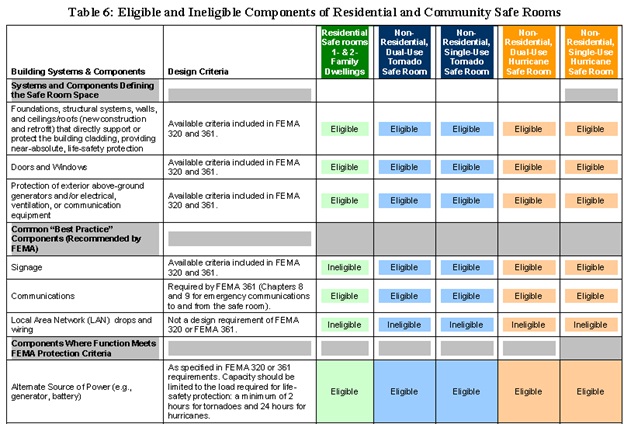
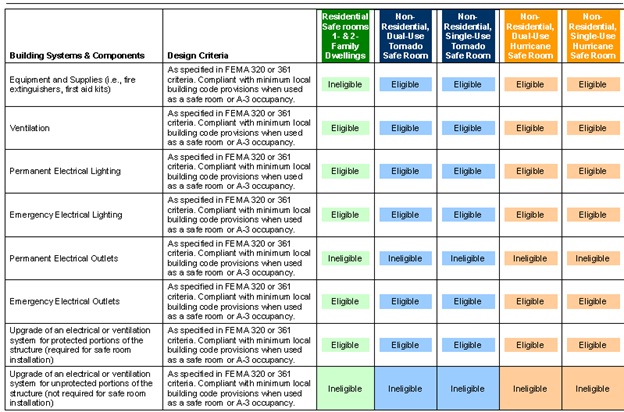
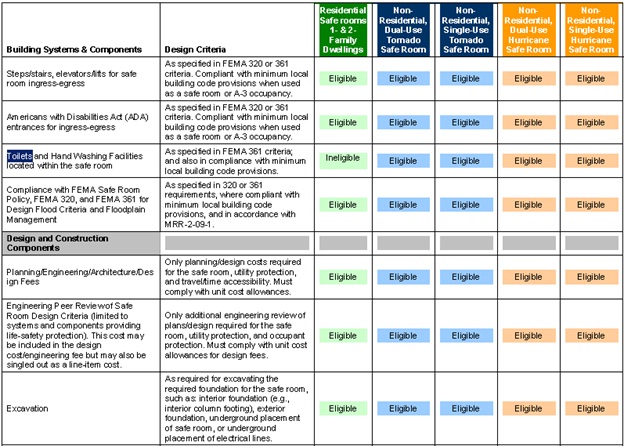
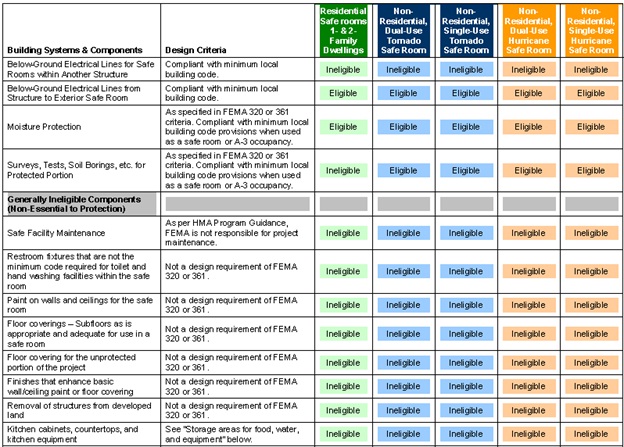
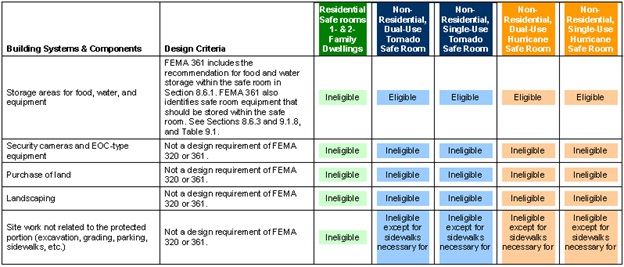
Does FEMA approve, endorse, or certify any products?
No. Federal No. Federal policy does not allow FEMA to approve, endorse, certify, or recommend any products. While a product may be in compliance with FEMA design guidance, any language from manufacturers stating their product is "FEMA approved" or "FEMA certified" is incorrect.
What is the recommended square footage per person for a residential tornado and hurricane safe room?
For residential safe rooms, the usable tornado safe room floor area should be the gross floor area minus the area of sanitary facilities, if any, and should include the protected occupant area between the safe room walls at the height of any fixed seating, if it exists. The minimum recommended safe room floor area per occupant for residential tornado and hurricane safe rooms is provided in table below. (Click the table to view it larger.)

What is the cost of installing a safe room in a new home or small business?
Costs for construction vary across the United States. The cost for constructing a safe room that can double as a master closet, bathroom, or utility room inside a new home or small business ranges from approximately $6,600 to $8,700 (in 2011 dollars). This cost range is applicable to the basic designs in FEMA P-320 (FEMA, 2008a) for an 8-foot by 8-foot safe room (approximately 64 square feet of protected space). Larger, more refined designs for greater comfort cost more, with 14 foot by 14-foot safe rooms ranging in cost from approximately $12,000 to $14,300. The cost of the safe room can vary significantly, depending on the following factors:
- The size of the safe room
- The location of the safe room within the home or small business
- The number of exterior home walls used in the construction of the safe room
- The type of door used
- The type of foundation on which the safe room is constructed
- The location of the home or small business within the United States
For additional cost information for small safe rooms in a home or small business, see FEMA P-320 (FEMA, 2008a), Section II, page 34.
As a homeowner, can I build the safe room on my own?
A homeowner who builds a safe room should be skilled in building construction. Some pre-fabricated safe rooms are available that require less building construction experience to successfully install. In purchasing any safe room, the homeowner should obtain sufficient documentation to determine that the safe room is built to the FEMA safe room design and protection criteria.
Can I install a safe room in an existing home?
Yes, though installing a safe room in an existing home or small business is typically more expensive and challenging than installing one in a new building. Modifying the walls or foundation of an existing building for the construction of a safe room is more complicated than constructing those elements new and, as a result, some of the prescriptive safe room designs provided in FEMA P-320 (FEMA, 2008a) are not practical for some existing homes. Typically, installing a safe room in an existing home costs 20 percent more than installing the same safe room in a new home under construction.
Due to the technical challenges involved in retrofitting an existing home for a safe room,
an architect or engineer should be consulted to address the structural issues and the wind-borne debris protection criteria, even when not required by the local building department. As such, homeowners must balance the desire to have protection within their home with the practicality of constructing a safe room outside the footprint of their existing home or structure for less money. For more information on retrofitting existing buildings with a safe room, see FEMA P-320 (FEMA, 2008a), Section II, page 25.
Is an underground safe room safer than one above ground?
As long as a safe room is designed to meet or exceed the criteria in FEMA P-320 (FEMA, 2008a) and FEMA P-361 (FEMA, 2008b), it will offer the same near-absolute protection whether it is above or below ground.
Where is the best location for the safe room?
There are several possible locations in or near your home or small business for a safe room. The most convenient location in many homes is in the basement. If there is no basement within the home, or if the walls of the basement do not meet FEMA P-320 (FEMA, 2008a) design criteria, an in-ground safe room can be installed beneath a concrete slab-on-grade foundation or concrete garage floor. In-ground and basement safe rooms provide the highest level of protection against missiles and falling debris because they are typically shielded from direct forces of wind and debris; however,
above-ground designs, such as the prescriptive designs provided in FEMA P-320 (FEMA, 2008a) or any solution following the criteria set forth in FEMA P-361 (FEMA, 2008b) will provide near-absolute protection.
Many individuals prefer to build within their homes or buildings so they have some level of
protection while attempting to access their safe room. For an existing home or small business, this convenience must be balanced with the challenges of retrofitting the building. For more information on selecting the location of a safe room within your home or small business, see FEMA P-320 (2008a), Section II, page 27.
Are inspections required?
Obtaining proper building permits and inspections is important for all construction. The builder or homeowner should ensure the safe room is built according to the plans in FEMA P-320 (FEMA, 2008a) or to plans that, through testing and engineering, have been determined to meet the safe room design criteria in FEMA P-320 (FEMA, 2008a) or FEMA P-361 (FEMA, 2008b). The level of construction needed for a safe room typically requires a permit from the local building department. Further, to verify compliance with the FEMA or International Code Council (ICC)-500 (ICC, 2008) criteria, additional quality control inspections for community safe rooms, and often for residential safe rooms, may be needed.
If the Storm shelter costs $6,000.00 can I get more than $2,000 reimbursed?
No, the Hazard Mitigation Program only allows reimbursements up to 75% of the approved costs.
I need to have my Storm Shelter money up front to pay my contractor. Is this possible?
No, The money is only available as a reimbursement, AFTER construction is completed and you have submitted signed and notarized documentation from your contractor stating your Storm Shelter meets or exceeds the specification set forth in FEMA Publication 320.
If I am eligible to receive the $2,000 rebate, do I have to consider that money as income for State and Federal Income Tax purposes?
No, in accordance with the Robert T. Stafford Disaster Relief and Emergency Assistance Act, as amended, these funds are considered free from tax liability under Federally funded assistance programs.
Sheriff
 View on map View on map
How to enter the Detention Center
"Serving Buffalo County with the assistance of our citizens!" 
Mission Statement: "The mission of the Buffalo County Sheriff's Department is to enhance the quality of life in our county by working cooperatively with the public and within the framework of the U.S. Constitution to enforce the law, preserve the peace, reduce fear and provide for a safe environment for all of our citizens."
Department Structure: The Buffalo County Sheriff's Office is organized into two divisions, Operations and Support Services, under the direction of the Sheriff who is elected for a four (4) year term. The Operations Division consists of Civil Process, Warrant Section, Investigative Section, and Patrol Section and is currently managed by a Captain. The Support Services Section consists of the Sheriff's
Staff Section, Community Services Section, Training Section, Communications Section, and Detention Center Section and is currently managed by the Chief Deputy.
Social Media:
 
LOCATION: The department offices are located at 2025 Avenue A in Kearney, Buffalo County, Nebraska.
Regular business hours are 8:00 a.m. to 5:00 p.m. Monday - Friday.
A unique joint venture with the Buffalo County Sheriff's Office and the Kearney Police Department was formed in July 1993 when both agencies co-located to a remodeled building in downtown Kearney. By sharing resources, both agencies save taxpayers' money as well as establishing a good working relationship between the agencies and their employees.
The Sheriff's office oversees the dispatch duties and answers 911 calls for officers of both agencies.
The Police Department oversees the records and data processing functions for both agencies.

The Buffalo County Sheriff's Office responds to calls that occur in the county (outside of Kearney city limits). The Kearney Police Department responds to calls that occur within the city limits.
Both agencies assist each other as needed as well as working with law enforcement officers from other local jurisdictions in Buffalo County, Public Safety at the University of Nebraska at Kearney, and the Nebraska State Patrol.
Civilian fingerprinting is available by Buffalo County Sheriff's Office. BY APPOINTMENT ONLY.
1) Call 308-236-1804 to schedule an appointment, Monday - Friday, 8:30-11:00 am and 1:00 - 4:00 pm.
2) Fee is $20.
3) Do not come if experiencing any symptoms that include.
a) fever of above 100 F
b) shortness of breath or difficulty breathing.
For Emergencies: Dial 911
2022 PREA Audit
2023 PREA Annual Report
|